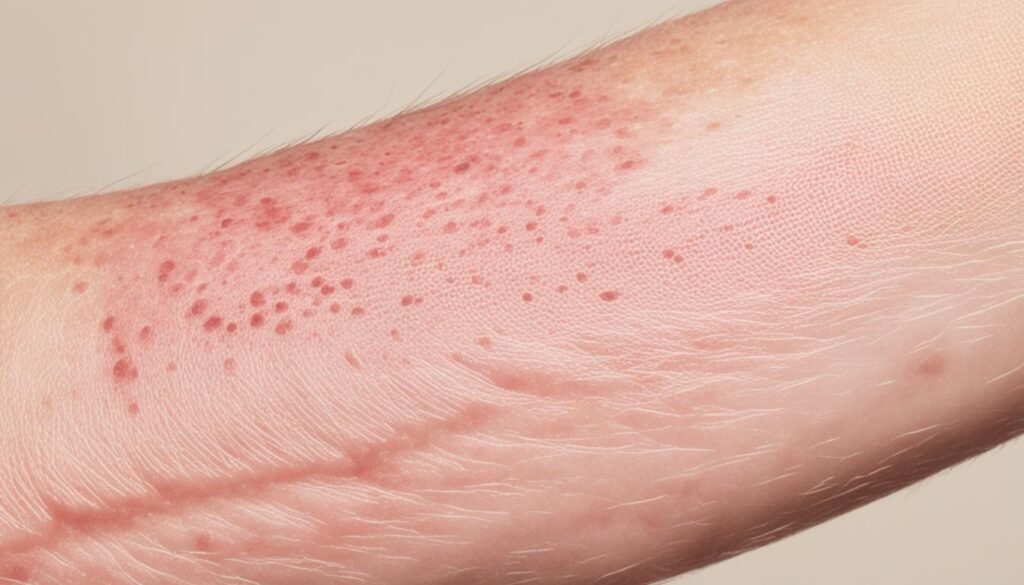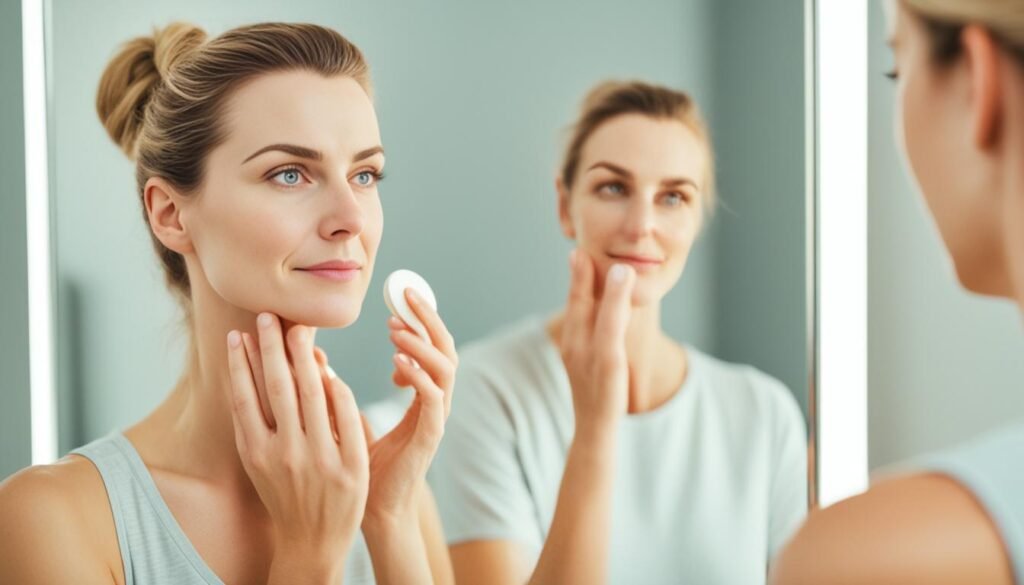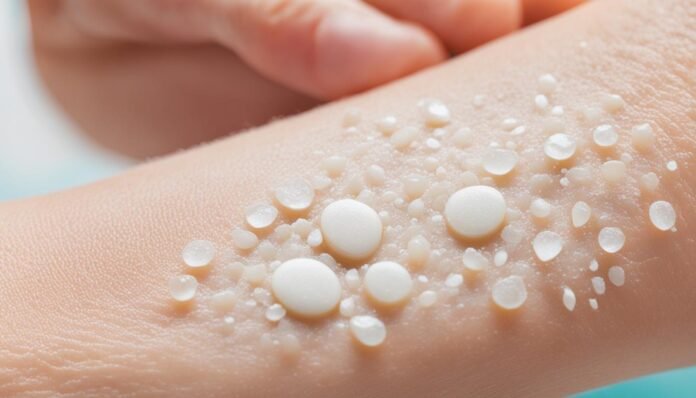Keratosis pilaris, known as KP or chicken skin, is when you get small, hard bumps. These bumps are rough, like sandpaper. They mainly show up on your upper arms, thighs, cheeks, or buttocks. They aren’t painful or itchy but can irritate sometimes. While there’s no cure for KP, many treatments and home remedies can help your skin look better.
To treat keratosis pilaris, focus on moisturizing and gentle exfoliation. Using the right skincare products and habits can help manage KP. Knowing what your skin needs and sticking to a care routine can really help. This way, you might achieve smoother, clearer skin.
Understanding Keratosis Pilaris
Keratosis pilaris, also known as KP or chicken skin, is common. It happens when keratin builds up, causing rough patches and tiny bumps.

What is Keratosis Pilaris?
KP happens due to keratin forming hard plugs inside hair follicles. It’s a widespread issue, affecting many people.
Common Symptoms
Chicken skin’s main signs are rough areas and small bumps. They feel like sandpaper. You’ll mostly find them on arms, thighs, cheeks, and buttocks.
The bumps can look red, white, or match your skin tone. They often stand out more in cold weather or dry places.
Who Gets Keratosis Pilaris?
KP usually starts in childhood or the teen years. It can get less severe as you get older.
People with a family history of KP, dry skin, eczema, asthma, or hay fever are more prone to it. Up to 40% of adults and 50-80% of teens have KP.
Causes of Keratosis Pilaris
Understanding the keratosis pilaris causes can help manage this skin issue better. Both genetic and environmental factors contribute to KP.
Genetic Factors
Keratosis pilaris often runs in families, showing a strong genetic link. If one parent has the gene, their children might also get KP. This is why many people say they have relatives with the condition.
Environmental Triggers
Environment plays a big part in keratosis pilaris causes. Low humidity and cold weather make KP worse by drying the skin. KP is more problematic in winter when the air is dry, leading to rough and bumpy skin. Keeping your skin moist in cold weather helps with KP symptoms.
Lifestyle and Home Remedies

Addressing keratosis pilaris at home means daily simple, effective steps. Include these keratosis pilaris solutions to better your skin. You’ll feel more at ease.
- Take shorter showers with warm (not hot) water to avoid stripping your skin of its natural oils.
- Use mild cleansers instead of harsh soaps to minimize skin irritation.
- Apply thick, non-comedogenic moisturizers to damp skin right after bathing to lock in moisture.
- Implement gentle exfoliation techniques, such as using a soft washcloth or a mild chemical exfoliant, to remove dead skin cells and prevent buildup.
- Incorporate a humidifier into your home to add moisture to the air and reduce skin dryness, which can help diminish the appearance of keratosis pilaris remedies.
- Avoid wearing tight clothing that can cause skin friction and aggravate KP bumps.
Follow these keratosis pilaris solutions and keratosis pilaris remedies for better managing of the condition. Regular routine practice is vital. It will enhance your skin’s health and look.
Best Skincare Products for KP
Are you fighting keratosis pilaris? Finding the right skincare can really improve your skin’s look and feel. Using the top products for keratosis pilaris can make a big difference.
Exfoliating Creams
For treating keratosis pilaris, exfoliating creams are a must. Choose creams with alpha hydroxy acid, lactic acid, salicylic acid, or urea. These help remove dead skin and soften it, making bumps less noticeable.
Moisturizers to Use
Keeping your skin hydrated is crucial for KP. The right moisturizers keep your skin smooth and calm. Look for products with lanolin, petroleum jelly, or glycerin. They lock in moisture, ease dryness, and protect the skin.
Using Humidifiers
Improving your environment can also help treat KP. Using humidifiers puts moisture back into the air, which fights the dryness linked to KP. They’re extra useful in winter when heating can make your skin drier.
| Product Type | Recommended Ingredients | Examples |
|---|---|---|
| Exfoliating Creams | Alpha Hydroxy Acid, Lactic Acid, Salicylic Acid, Urea | AmLactin Daily, CeraVe SA Lotion |
| Moisturizers | Lanolin, Petroleum Jelly, Glycerin | Aquaphor Healing Ointment, Eucerin Intensive Repair |
| Humidifiers | – | Honeywell Cool Moisture, Vicks Filter-Free Ultrasonic |
Professional Treatments
When home solutions and store-bought products fail, consider professional treatments for keratosis pilaris. Dermatologists have advanced options to better manage KP’s look.
Medicated Creams
Dermatologists often prescribe medicated creams for keratosis pilaris. These creams use strong ingredients like topical exfoliants or retinoids. They work better than over-the-counter options by aiding skin renewal and avoiding follicle clogs.
Laser Treatments
Laser treatments are great for ongoing redness and swelling. They can greatly reduce skin redness and make the skin smoother. It’s key to see a board-certified dermatologist to get a treatment plan that fits your skin type and KP severity.
Daily Skincare Routine for Keratosis Pilaris
Creating a successful daily skincare routine for keratosis pilaris helps keep skin smooth and healthy. It’s important to be consistent. Adding specific steps to your routine can really help.
Start your routine with gentle exfoliation. Choose mild chemical exfoliants like alpha hydroxy acid or salicylic acid. They remove dead skin cells that block pores. Regularly getting rid of these cells will make your skin feel smoother.
Hydration is key after exfoliating. Use a moisturizer with urea, glycerin, or petroleum jelly. These ingredients keep moisture in and soften dry, rough areas.
Include these steps in your daily skincare routine for keratosis pilaris:
- Wash with a gentle, soap-free cleanser to keep skin moisturized.
- Exfoliate lightly with a chemical product 2-3 times a week to prevent irritation.
- Twice a day, especially after showering, apply a thick moisturizer to keep skin hydrated.
- Add a humidifier to your space to increase air moisture, especially in dry months.
Sticking to this daily skincare routine for keratosis pilaris can help keep your skin soft and smooth, avoiding rough patches.
Conclusion
Keratosis pilaris, or KP, can be managed well with the right routine. Knowing about KP and the correct treatments helps a lot. Using soft exfoliation, keeping the skin moist, and using special treatments are key.
Remember, results take time. Being patient and consistent is very important. Choose treatments that fit your skin’s needs, whether they’re home remedies or professional advice. Products with alpha hydroxy acid or urea are very helpful for your skin.
If store-bought treatments don’t work, see a dermatologist for stronger options. They might suggest medicated creams or laser therapy for tough KP. By updating your skin care plan and getting advice from experts, smoother and clearer skin is possible. This shows that there are effective ways to treat keratosis pilaris.





